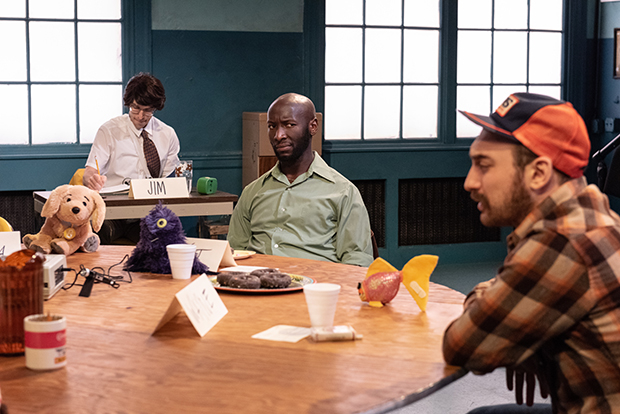Parents Clash Over Children's Television in Mrs. Murray's Menagerie
The Mad Ones re-create a focus group circa 1979 for their latest devised play.

(© Ben Arons Photography)
Why would anyone want to sit in a room with strangers and argue about TV — and why would we want to watch them do it? Visitors to Greenwich House Theater (new home to Ars Nova) might have that knee-jerk response to Mrs. Murray's Menagerie, a play about a focus group circa 1979. They ought to consider the focus group occurring on Facebook and Twitter at this very moment, a never-ending event with more than a few lurkers. At least the characters in Mrs. Murray's Menagerie are compensated for their time and data. In 2019, we give it away for free.
Collaboratively written by the Mad Ones (the downtown troupe led by director Lila Neugebauer) and additional non-mad members of the cast, Mrs. Murray's Menagerie takes its title from a fictional children's television show about a jazz singer who lives in a house full of talking animal puppets. Research company Blue Horizon has been contracted to survey six kids and their parents about the show. Company representative Dale (Brad Heberlee, channeling the voice of NPR's Peter Sagal) leads the parental group, asking them to respond to aspects of the show in a few words as his associate Jim (Marc Bovino, a bundle of nerves suppressed under a mop of hair) struggles to write their answers on a chalkboard.

(© Ben Arons Photography)
We get to know a little bit about the parents as they speak: June (a softly mean Carmen M. Herlihy) can't help mentioning that her husband is a doctor and that they own a swimming pool. Wayne (a magnificently mustachioed Michael Dalto) works in tool and die. Ernest (Phillip James Brannon, powerfully playing to his character's name) owns a bookstore and loves that Mrs. Murray is black like him. Gloria (a gloriously uncomfortable Stephanie Wright Thompson) seems daunted by the task of disciplining her son. Temperamentally, she is the opposite of Celeste (a commanding January LaVoy), a woman with intense bangs and a smile that says, I mean business, mister. The final member of the group is Roger (a combustible Joe Curnutte), a salesman who is accustomed to being liked — and lashes out when he's not.
The discussion remains cordial, until the group begins critiquing the way Mrs. Murray deals with discipline, exposing a rift between the parents who think she is too lenient and those who think she has the right approach. More divisions arise when the parents start assigning races to the plushy animals. Others see certain characters as representative of their own children, and we see just how strong the impulse is to project one's hopes and fears onto an outside figure (be it a politician or a puppet). Will their comity hold when things become so personal?

(© Ben Arons Photography)
The Mad Ones revealed an uncommon gift for depicting passive-aggression in their last play, Miles for Mary, about a group of Ohio high school teachers organizing a charity telethon. Under the thorough ensemble-centric direction of Lila Neugebauer, that gift remains as rewarding as ever as we chart the dagger glances and strained voices in the room.
That Philadelphia community center meeting room is exquisitely realistic as created by set designers You-Shin Chen and Laura Jellinek. The morning light shines in through big upstage windows (pick-me-up lighting design by Mike Inwood). Ásta Bennie Hostetter outfits the cast in authentic retro costumes, but the real wow factor comes from Alfreda "Fre" Howard's hilarious hair and wig designs. Justin Ellington has composed original earworm theme songs for Mrs. Murray, which sound designer Stowe Nelson produces with '70s stereo quality. At every step, Neugebauer and the Mad Ones exhibit an attention to realistic detail that is impressive to behold — even if it doesn't add up to the laugh-out-loud comedy of the year.

(© Ben Arons Photography)
Instead, Mrs. Murray's Menagerie is the kind of intricate, quiet comedy that grows more resonant in the hours and days following the curtain call. Audience members will likely walk away confused by the dearth of peaks and valleys in this amble through the data-collection practices of the near past. After seeing the Mad Ones build their sandcastle for an hour, we expect that we will be rewarded with a spectacular foot-stomping demolition. Disappointingly, that moment never comes — although that may be the point.
We get the sense that sitting face-to-face in the same physical space encourages some restraint in these adults. A final scene depicts the 1979 equivalent of typing a nasty Facebook missive and then choosing to hit delete. Were these parents giving their opinions from behind the relative anonymity of a screen, they might be less inhibited. That's great for data collectors like Dale, but it feels pretty destructive for society. In their own understated way, the Mad Ones suggest that the next time we're about to say something mean on the Internet, we ought to think about how Mrs. Murray (or Mister Rogers) might respond.








